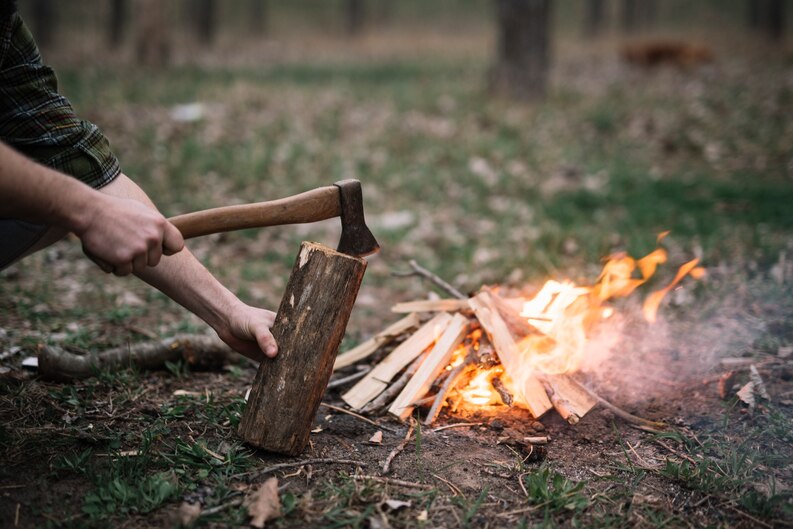Fire is more than just a source of light & warmth; it’s also a crucial element for survival in the wilderness. Mastering the art of starting & maintaining a fire is a skill that every adventurer should possess. Through this article, you’ll delve into the basics of fire craft, from understanding the fire triangle to gathering suitable fuel.
In addition, you’ll also explore different fire-starting methods and building structures that ensure sustainability. Moreover, we’ll discuss fire safety, maintenance, and techniques for challenging environments. Firecraft is not only practical but also essential for boosting morale & signaling for rescue. Join us on this journey of mastering the art of fire craft for survival.

The Fire Triangle: Understanding the Basics
To truly grasp the art of starting & maintaining a fire, it is essential to understand the basics of the fire triangle. This triangle primarily consists of 3 elements – Fuel, Heat, and Oxygen. Each element plays a crucial role in sustaining a fire. Here’s a breakdown of those crucial elements:
- Fuel. Identifying suitable materials such as dry grass, leaves, and bark.
- Heat. The ignition source raises the fuel’s temperature to its ignition point.
- Oxygen. It supports combustion by providing the necessary air supply.

Balancing these components is key to successfully starting & maintaining a fire in any survival situation.
Gathering Fuel: Choosing the Right Materials
When it comes to starting a fire for survival, choosing the right materials for fuel is essential. Simply remember the key considerations as explained in this section:
- Tinder. Look for natural tinder that is dry and easily ignitable, such as dry leaves & grass. These materials catch fire quickly and help ignite larger fuel sources.
- Kindling. Collect small twigs & branches, preferably from dead trees or fallen branches. These thin pieces of wood provide the initial frame and help sustain the fire as it grows.
- Fuel Logs. Seek out larger pieces of wood, known as fuel logs, to maintain a steady fire. Look for dead-standing trees or fallen logs that are dry and free from moisture.
- Quantity. Gather enough fuel to last throughout your fire. It’s better to have more than you think you’ll need, as it can be challenging to find additional fuel once the fire is burning.

Remember, the right materials are crucial for starting & maintaining a fire. Take time to gather fuel, ensuring that it is dry, easily tangible, and available in sufficient quantities. This will increase your chances of successfully building and sustaining a fire in a survival situation.
Fire Starting Methods: Tools & Techniques
When it comes to starting a fire in a survival situation, having a range of fire-starting methods at your disposal is crucial. Here are some essential tools & techniques to consider:
Friction-Based Methods
- Bow Drill. This method involves using a bow to rotate a wooden spindle against a fireboard, creating friction, and generating an ember.
- Hand Drill. By rapidly rotating a wooden stick against a fireboard using hand pressure, you can produce an amber.
Modern Tools
- Matches. Waterproof matches are a reliable fire-starting tool. Ensure they are stored in a waterproof container to protect them from moisture.
- Lighters. A windproof lighter provides a convenient & efficient way to ignite tinder and start a fire.
Natural Ignition Sources
- Flint & Steel. Striking high-carbon steel against a flint rock creates sparks, which can ignite dry tinder.
- Magnifying Glass. Using the sun’s rays focused through a magnifying glass can create enough heat to ignite tinder.
Remember to practice & familiarize yourself with these fire-starting methods & tools before you find yourself in a survival situation. Having a diverse set of options will increase your chances of successfully starting a fire, regardless of the circumstances.

Building a Fire Structure: The Key to Sustainability
When starting a fire for survival, the way you construct your fire structure plays a vital role in its sustainability. Here are some key considerations for building a fire structure:
Fire Structure Types
- Teepee. Arrange your kindling in a cone shape, leaving a gap at the top for airflow. Place the Tinder bundle at the center. As the fire grows, add larger fuel logs around the teepee structure.
- Long Cabin. Create a square or rectangular base by altering layers of kindling & fuel logs. Place the tinder bundle at the center and continue building upward, leaving gaps for airflow.
Arranging Fuel
- Gradation. Start with small twigs and gradually increase the size of the fuel logs. This allows for a steady progression of combustion and maintains a consistent heat level.
- Airflow. Ensure there is enough space between the fuel logs for air circulation. Sufficient airflow helps the fire burn efficiently and reduces the likelihood of smothering the flames.
Foundation
- Clear the Area. Remove any debris, dry grass, or leaves from the ground where you plan to build your fire. This helps prevent the accidental spreading of the fire.
- Use Rocks or a Fire Ring. Create a boundary around your fire area using rocks or a designated fire ring available. This helps contain the fire within its boundaries.
By carefully constructing your fire structure and arranging the fuel properly, you can create a sustainable & efficient fire that provides warmth, cooking capabilities, and comfort in a survival situation.
Wrapping It Up
Fire is more than just a source of light & warmth; it is also crucial for survival in the wilderness. Mastering the art of starting & maintaining a fire is a skill that every adventurer should possess. Through this article, we explored the basics of fire craft, including understanding the fire triangle and gathering suitable fuel. The article discussed various fire-starting methods and the importance of choosing the right materials.
In addition, we also covered the key considerations for building a fire structure to ensure sustainability. By understanding these concepts & techniques, you can enhance your ability to start & maintain a fire in a survival situation, increasing your chances of survival & comfort.




















